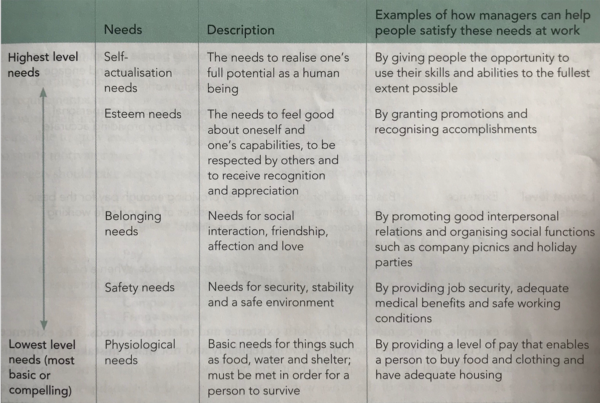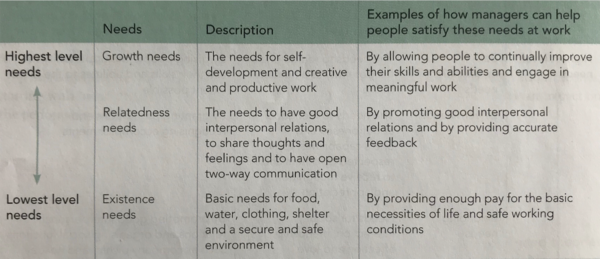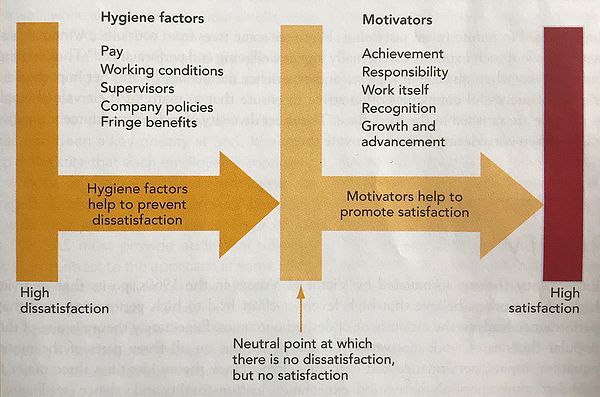Need-Based Theories of Motivation
Contents |
Abstract
A need is a requirement or necessity for survival and wellbeing. The basic premise of need theories is that people are motivated to obtain outcomes at work that satisfy their needs. Need theories suggest that to motivate a person to contribute valuable inputs to a job and perform at a high level, a manager must determine what needs the person is trying to satisfy at work and ensure that he og she receives outcomes that help to satisfy those needs in return for performing at a high level and helping the organisation achieve its goals.
This article has focus on some of the need theories and how these are connected to each other. It states how managers can help people satisfy their needs at work. Lastly the limitations are mentioned.
Need Theories
Maslow’s Hierarchy of Needs
- Physiological needs
- Safety needs
- Belongingness needs
- Esteem needs
- Self-actualisation needs
Alderfer's ERG Theory
- Existence needs
- Relatedness needs
- Growth needs
Satisfaction/Progression
Frustration-Regression
McClelland's Need Theory
- Need for achievement
- The extent to which an individual has a strong desire to perform challenging tasks well and to meet personal standards for excellence.
- Need for affiliation
- Need for power
Herzberg's Motivation-Hygiene Theory
Comparison
DRAFT
In 1943 Abraham Maslow stated that all people seek to satisfy five stages of needs, which come in a particular order. In the 1960 Abraham Maslow proposed that there are five stages of human needs that motivate our behaviour. Better known as Maslow's hierarchy of needs. These stages are psychological needs, safety needs, belonging needs, esteem needs and self-actualization needs which are described in more details in the figure below, better known as Maslow's hierarchy of needs. His idea is that the lowest level needs must be met before a person strives to satisfy needs higher up in the hierarchy. Once a need is satisfied, it ceases to operate a source of motivation.This theory identifies some needs which are an importation source of motivation for many people, but he argues that only one level is motivational at one time. Maslow's hierarchy of needs proposed that individuals progress from one need to another once they are satisfied. Abraham Maslow stated that people have which come in a espiaclly needs.
Clayton Alderfer observed that individual needs differ according to circumstances. They do not need to move in an order of progression. Because of this he devised the ERG Theory which talks about three conditional stages: existence, relatedness and growth
Cleary, there are more need theories. Those mentioned above are the most known and therefore they are compared in the figure below.
Application
This section is in progress.
(Managers must realize that citizens of different countries might differ the needs they seek to satisfy through work. In countries like Greece and Japan they are especially motivated by safety needs, whereas they in Scandinavia are motivated by belongingness needs. People in countries which become wealthier and have higher standards of living, needs related to personal growth and accomplishment become important motivators of behaviour. Other variables are age, stage of life, gender, impact of family commitments and outside-interests.)
Limitations
This section is in progress.
- Not everyone has the same needs.
- Our perception of what is important at work will vary.
- Not realistic that most employees will reach the top of the hierarchy.
Annotated bibliography
This section is in progress.
Di Waddell, Gareth R. Jones and Jennifer M. George (2013). Contemporary Management (3rd ed.).
https://wikispaces.psu.edu/display/PSYCH484/2.+Need+Theories



